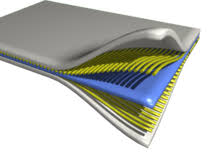An Introduction to Composite Coating
Though metals might seem incredibly tough by themselves, they can often succumb to corrosion or damage from heat and UV rays. This is where composite coating comes in.
What exactly is composite coating?
Composite coating, much like onions (and ogres), is all about layers. Protective layers are applied to something known as a substrate, the material you want to protect. Substrates can be anything, but are most commonly metals.

The coating consists of a series of layers. These are, typically, an adhesive-treated substrate, a primer, a base coat and a top coat. These layers are gradually applied, eventually forming a tough and resistant material with more protective features than the original substrate had. Information on the adhesives can be found here:
What do we need it for?
Composite coatings are most often used for protection, whether it be additional toughness or resistance to corrosion, heat or UV light. Metals don’t usually need to be made stronger, but protection against corrosion is an often-sought feature. Common metals include nickel composites, for which you can find advice and services online, such as at poeton.co.uk/advanced-treatments/apticote-460-nickel-composites.

The practice is invaluable in many fields, ranging from construction and manufacturing all the way up to aerospace.
How is it done?
The most common method of application is spraying, although products can also be dipped, rolled or brushed, depending on your resources and needs.
Spraying is the fastest method, but also the most wasteful. Depending on your location and available resources, this can be a great or wasteful method. Compare the automotive industry to spraying some roof panels in the wind, for instance.
Brushing is almost the opposite, being less wasteful but slower than spraying. This method is also more labour-intensive, often requiring additional coats to ensure proper coverage. Most often, this method is recommended for the base coat.
Dipping allows for quick coating. However, it requires plenty of product, and for your product to fit inside the container, massively limiting its uses.
Rolling is similarly specific in its uses, being quicker than brushing, but unable to provide effective coverage on everything – steel cladding, for example.
